Batasha Is The Diwali Sweet Treat That Packs A Satisfying Crunch
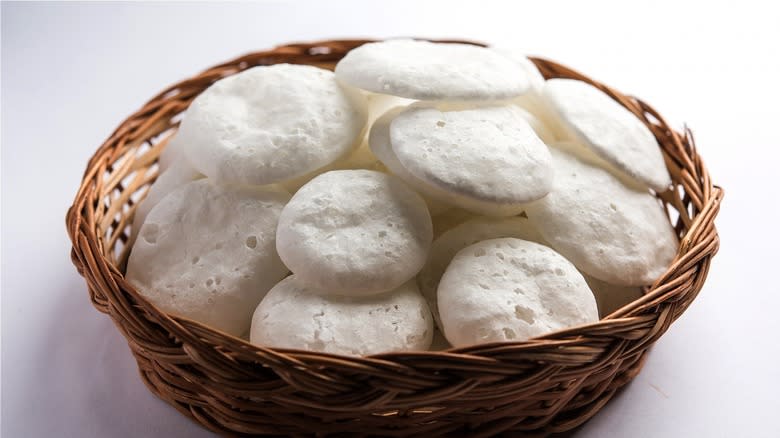
Diwali may be the Festival of Lights, but it's just as much about the candies as the candles. A glorious celebration of all things sugary, as sweet as February 15 (which marks the date of another favorite holiday of ours, Half-Price Chocolate Day). Diwali candies come in all shapes and flavors including the almond fudge known as badam burfi, the cashew candies called kaju katli, and the coconutty kopra pak. One enduringly popular treat, however, is batasha, one of the older and plainer styles of candy.
Batashas are basically sugar-flavored since that is the primary ingredient. In fact, it was thought that making or eating these sweet crispy treats back in ancient times may have been a way to flex on the fact that you could afford the sugar to make the stuff. (Sugar was a lot pricier before industrialization, imperialism, and slave labor made it available to the masses.) These days, however, batasha serves a far more elevated purpose as it is traditionally used as a Diwali offering to the Hindu goddess Lakshmi. You needn't be a deity nor a member of the nobility to enjoy these candies, though, since they are also available for the enjoyment of anyone else with a sweet tooth.
Read more: The Most Unique Chip Flavors Ever To Grace Store Shelves
History Of Batasha
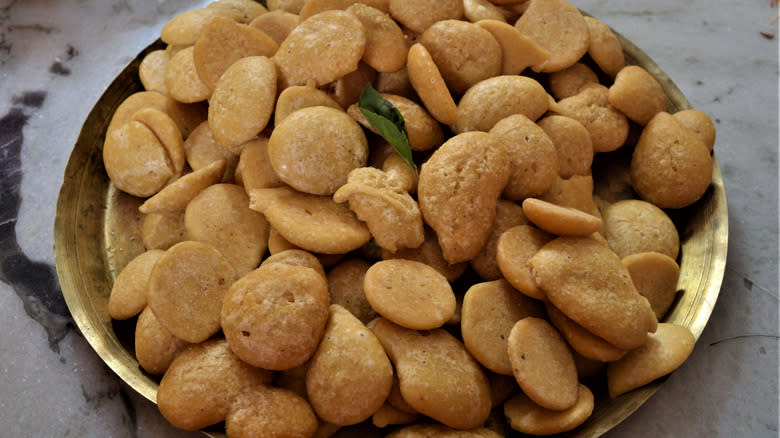
Batasha, it is said, has roots that stretch back to the Mughal Empire which lasted from the 16th to 18th centuries. Yet another origin story says the candy was created when Silk Road trade was thriving, which would date it to the 15th century or earlier. One of the sweetest stories about batasha, however, is the part it's supposed to have played in facilitating an imperial marriage.
As the tale goes, Jehangir (aka Jahāngīr or Nūr al-Dīn Muḥammad Salīm), India's Mughal emperor between 1605 and 1627, was strolling through his royal harem one day, as one did when one was an emperor back in the day. As he approached the batasha stall in the bazaar that served the needs of the harem residents, who should he see but the lovely Mehr al-Nesāʾ (later known as Jahān), who was one of his mother's ladies-in-waiting. She was apparently stuffing her face with batashas at the time, which naturally charmed the emperor since all the world loves a candy lover. While history does not record the exact interaction, we like to imagine her responding to his romantic overtures with a heartfelt "Mmmmmppphhh!"
Why Is Batasha Associated With Diwali?
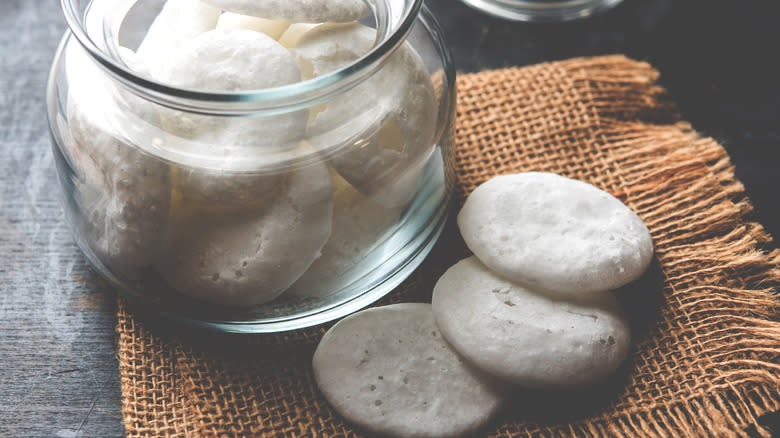
One reason that batasha is seen as Diwali-appropriate is that this simple sugar candy is typically associated with the fall. This dates back to the olden days of sugar harvesting when this now-staple ingredient actually had a season. Batashas, then and now, were offered up at temples to give thanks for a good harvest and ensure that future ones, too, would also be successful.
Even though Diwali is not strictly a harvest festival anymore, it did originate as such, even though now it is seen more as a general "light triumphing over darkness" type thing. Still, it does not coincide with the winter solstice (the turnaround point after which days become longer than nights) but takes place closer to Thanksgiving, a holiday with similar agrarian roots. Ritual offerings at temples are still a part of Diwali celebrations as these are intended to ensure a year of peace, prosperity, and good health. Batashas, it seems, are just the type of simple sweets favored by the Hindu goddess Lakshmi, bringer of good fortune, as well as Lord Kuber (or Kubera), the god of wealth.
How Batasha Is Made
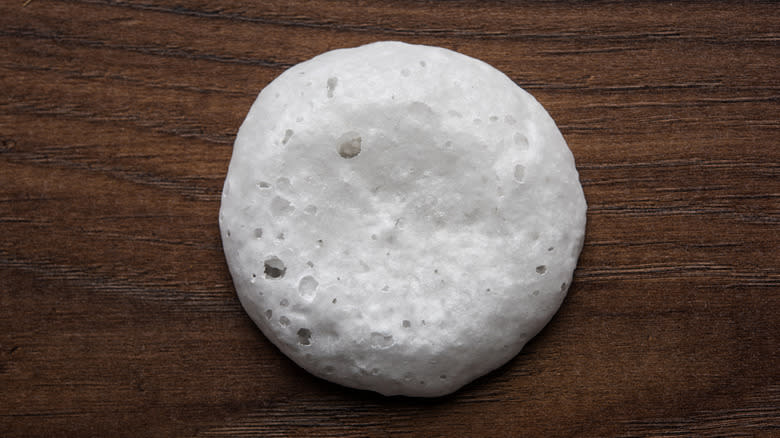
The earliest batashas were made with the unrefined type of sugar known as jaggery which comes from the sugar canes that have been cultivated in India for over 3,000 years. While batasha today may be made with refined white sugar instead, some mass-produced batashas include a mixture of both types or may include a small amount of palm jaggery (karupatti) derived from date palms. The sugar is mixed with water and simmered, being stirred all the while, until it forms a thick syrup. Once it has reached the proper consistency, it's taken off the heat, and some baking soda is stirred in to provide some aeration. This gives the candy a meringue-like appearance and consistency despite the fact that it contains no egg white.
Homemade batasha recipes may or may not include baking soda, although the consistency of the former kind is likely to be denser due to the fact that less air will get trapped in the sugar-water mixture. If you do add the soda, though, it will go in after the sugar syrup has cooked, as is the case when batashas are commercially prepared. The syrup is then poured out in a disc or drop shape onto a surface such as buttered paper or foil from which the candies can easily be detached once they've cooled down.
Batasha Variants
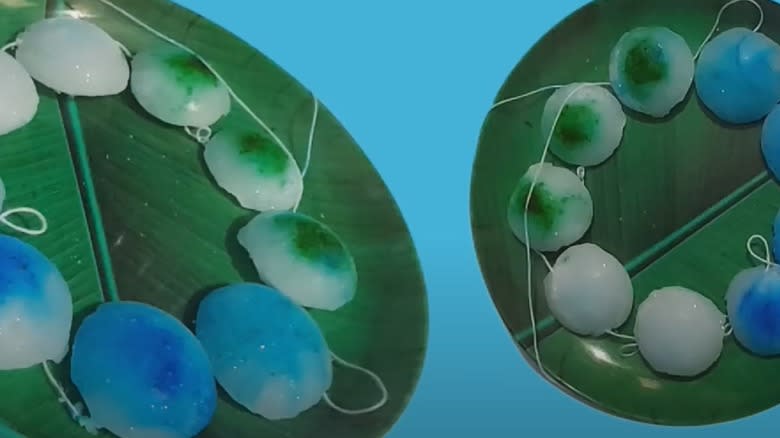
While most batasha is made with nothing more than sugar, water, and (maybe) baking soda, it is possible to embellish the candy with the addition of food coloring or perhaps some flavoring such as cardamom and some batasha may also include ghee. Different regions, too, seem to have their own variants. Batashe ki mala is a specialty of Bihar, Delhi, Chhattisgarh, and Uttar Pradesh. It is often tinted with some type of food coloring and may also be made in special candy molds tied together with rope or string so that when the sugar syrup sets, the pieces will be linked together to form a candy chain.
Batasha har is a type of batasha made in Maharashtra that also comes in the form of a chain and may be colored, as well. These candies have a special ritual purpose: On Gudi Pavda (Maharashtrian New Year), batasha har garlands and neem leaves bedeck each gudi (flag) flown outside the home from sunrise to sunset. Yet another type of candy is kodma batasha, which also goes by the Telugu name of panchadara chilakalu or "sugar parrot" because of its birdlike shape. This treat is traditional for the festival known as Makar Sankranti which marks the beginning of the January harvest. (Temperatures throughout India can range from the 60s up into the 80s during this winter month.) Batashas are sometimes formed into other animal shapes or even little dolls, too, as is done in Bengal, Bihar, and Uttar Pradesh.
How And When Is Batasha Eaten
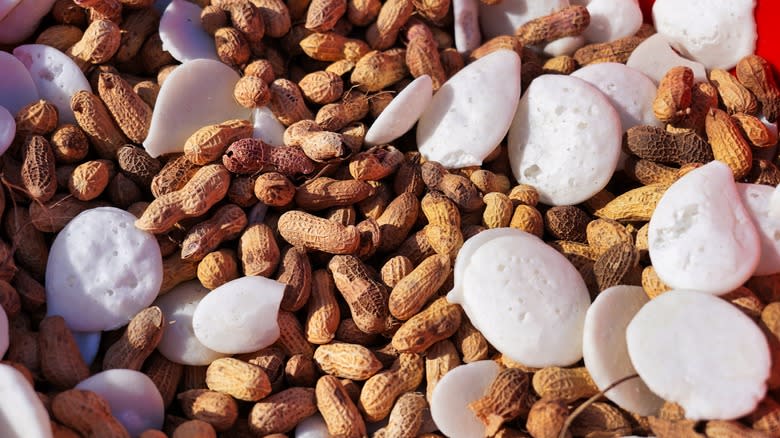
Batasha is not only a Diwali special but is offered up at temples, gurudwaras (Sikh places of worship), and home altars throughout the year. One reason why batatas are such a popular offering may be that, unlike in olden times, they are now pretty cheap to make. They are also something that lasts a good long time since with just sugar, water, and no moisture, they're unlikely to spoil even at room temperature.
While batasha may be served as a treat along with other candies or snacks such as peanuts, for ritual purposes it's typically offered alongside the puffed rice known as kheel. The two were originally paired because they were the fruits (metaphorically speaking) of two major fall crops: sugar cane in the case of batasha and rice, of course, for kheel. In fact, batasha may even be used to flavor kheel to make a dish called kheel batasha. Not only does this dish combine the two harvest symbols, but it serves a more practical purpose, as well. During the days of Pitru Paksha, which is another autumn festival, some Hindus fast in order to honor their ancestors. Kheel baksha is often used to end the fast because it is a mild type of food that's easy on the stomach and helps ease the transition back to more substantial fare.
Where To Buy Batasha
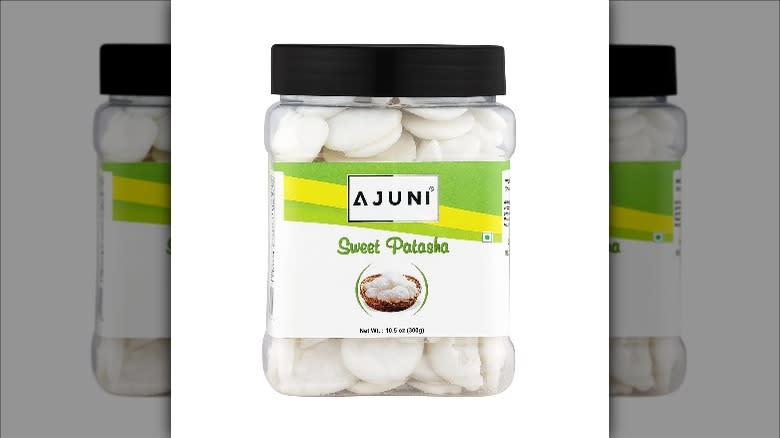
If you are in India, you'll be able to find batasha in homes, temples, and stores, particularly as Diwali approaches. In the U.S., too, you may be able to find it at groceries specializing in South Asian imports. In fact, even specialty versions such as batasha har may be available for purchase.
If you want to widen your options to include online purchasing, there are numerous different brands and types of batashas for your consideration. As per Amazon's helpful hint, though, you may need to try a variant spelling such as "patasha." This retailer of all the things of course has several varieties of batasha for sale, including a light brown lal batasha made with jaggery. NavaFresh, a website specializing in nutritious foods, offers a surprising variety of batashas (nutritious? Well, if they say so, we're okay with it). Most are the snow-white kind made with refined sugar, but some are made with jaggery, while combo packs are available for the undecided. NavaFresh also sells kheel batasha as well as batasha packaged with other prasada snacks meant for offering to the gods (and then eating oneself, as Hindu deities don't mind sharing).
Read the original article on Mashed.

